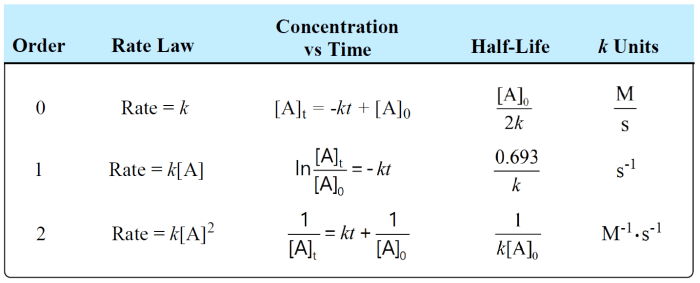Constants to know for mcat – Embark on a captivating journey into the realm of constants essential for MCAT mastery. These numerical pillars underpin the very foundation of science, guiding our understanding of the physical, chemical, biological, and mathematical realms. Prepare to unravel their significance and unlock the secrets to MCAT excellence.
From the cosmic dance of light to the intricate symphony of chemical reactions, from the delicate balance of biological systems to the abstract beauty of mathematical equations, constants serve as unwavering beacons, illuminating our path towards a deeper comprehension of the world around us.
Physical Constants

Physical constants are fundamental values that describe the physical universe. They are used in a wide range of calculations and play a crucial role in understanding the behavior of matter and energy.
The following table lists some of the most important physical constants that you should know for the MCAT:
| Constant | Value | Significance |
|---|---|---|
| Speed of light in vacuum | 299,792,458 m/s | The speed at which light travels through a vacuum. It is one of the most fundamental constants in physics and is used to define the meter and the second. |
| Gravitational constant | 6.674 × 10-11 N m2/kg2 | The constant that determines the strength of the gravitational force between two objects. It is used to calculate the force of gravity between planets, stars, and other celestial bodies. |
| Planck’s constant | 6.626 × 10-34 J s | The constant that relates the energy of a photon to its frequency. It is used to calculate the energy of light and other forms of electromagnetic radiation. |
| Boltzmann constant | 1.380 × 10-23 J/K | The constant that relates the temperature of a system to its entropy. It is used to calculate the entropy of gases and other systems. |
| Avogadro’s number | 6.022 × 1023 mol-1 | The number of atoms or molecules in one mole of a substance. It is used to convert between the number of atoms or molecules and the amount of substance. |
Chemical Constants: Constants To Know For Mcat

Chemical constants are numerical values that are used in various chemical calculations. These constants are derived from experimental measurements and are widely accepted within the scientific community. In MCAT chemistry, a thorough understanding of these constants is essential for solving problems and interpreting data.
Ideal Gas Constant
The ideal gas constant, denoted by R, is a proportionality constant that relates the pressure, volume, and temperature of an ideal gas. It is used in the ideal gas law, which describes the behavior of gases under various conditions. The value of R is:
R = 0.0821 L·atm/(mol·K)
This constant is used in calculations involving gas properties, such as volume, pressure, and temperature.
Faraday Constant, Constants to know for mcat
The Faraday constant, denoted by F, is the charge of one mole of electrons. It is used in electrochemical calculations, particularly in the context of electrolysis and redox reactions. The value of F is:
F = 96,485 C/mol
The MCAT is a beast of a test, and knowing the constants is crucial. For those looking to brush up on their chemistry, AP Chemistry Unit 6 FRQ is a great resource. It covers essential concepts like equilibrium constants, gas constants, and acid dissociation constants.
By mastering these constants, you’ll have a solid foundation for tackling the MCAT’s chemistry section.
This constant is used to determine the amount of charge passed through an electrochemical cell and to calculate the number of moles of reactants or products involved in an electrochemical reaction.
Standard Reduction Potentials
Standard reduction potentials are a set of values that represent the tendency of a substance to undergo reduction under standard conditions. They are used in electrochemistry to predict the spontaneity of redox reactions and to calculate cell potentials. Standard reduction potentials are tabulated for various half-reactions and are expressed in volts (V).
These constants are essential for understanding the behavior of gases, electrochemical processes, and redox reactions. By incorporating them into calculations and interpretations, students can gain a deeper understanding of chemical principles and apply them to solve MCAT chemistry questions effectively.
Biological Constants

Biological constants are numerical values that describe the fundamental physiological characteristics of living organisms. These constants play a crucial role in maintaining homeostasis and ensuring the proper functioning of biological systems.
Body Temperature
- Definition:The average temperature of an organism’s body.
- Physiological Significance:Body temperature is essential for regulating metabolic reactions, enzyme activity, and the proper functioning of organs and tissues.
Blood pH
- Definition:A measure of the acidity or alkalinity of blood.
- Physiological Significance:Blood pH must be tightly regulated within a narrow range (7.35-7.45) to ensure proper enzyme function, cellular metabolism, and nerve transmission.
Heart Rate
- Definition:The number of times the heart beats per minute.
- Physiological Significance:Heart rate is a key indicator of cardiac function and provides information about blood flow, oxygen delivery, and the body’s response to stress or exercise.
Mathematical Constants

Mathematical constants are numerical values that appear frequently in various scientific and mathematical applications. On the MCAT, you may encounter several mathematical constants that are commonly tested.
Pi
Pi (π) is the ratio of a circle’s circumference to its diameter. It is an irrational number approximately equal to 3.14.
Applications on the MCAT:
- Calculating the circumference and area of circles
- Solving trigonometric equations
- Modeling periodic functions
Euler’s Number
Euler’s number (e) is the base of the natural logarithm. It is an irrational number approximately equal to 2.718.
Applications on the MCAT:
- Solving exponential equations
- Modeling population growth and decay
- Calculating probabilities in statistical distributions
Golden Ratio
The golden ratio (φ) is an irrational number approximately equal to 1.618. It is often found in nature and art, and is believed to represent an aesthetically pleasing proportion.
Applications on the MCAT:
- Analyzing proportions in biological structures
- Solving geometric problems involving ratios
- Understanding the Fibonacci sequence
Clarifying Questions
What is the significance of the speed of light in vacuum?
The speed of light in vacuum is a fundamental constant that governs the propagation of electromagnetic waves. It plays a crucial role in understanding the nature of light, the behavior of particles, and the very fabric of spacetime.
How is the gravitational constant used in MCAT physics?
The gravitational constant quantifies the strength of the gravitational force between two objects. It is essential for calculating gravitational forces, predicting the motion of celestial bodies, and understanding the dynamics of the universe.
What is the physiological significance of body temperature?
Body temperature is a vital indicator of overall health and metabolic activity. It plays a crucial role in regulating enzyme function, maintaining cellular homeostasis, and supporting immune responses.
How is Euler’s number used in MCAT mathematics?
Euler’s number is a transcendental constant that appears in a wide range of mathematical applications. It is particularly useful in calculus, complex analysis, and probability theory, providing insights into the behavior of functions and the nature of mathematical sequences.